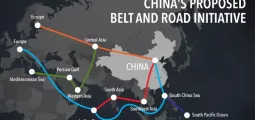World Bank Group’s PREM: Harnessing Trade Opportunities for Growth and Development

Otaviano Canuto, Vice President and Head of the Poverty Reduction and Economic Management Network, The World Bank
The pace of global trade integration over the past two decades has been extraordinary. Trade has been a key driver of global growth, convergence, and poverty reduction. During 1983–2010, global trade grew twice as fast as gross domestic product (GDP). Developing countries in particular have benefited—on average annual exports from low- and middle-income countries have expanded some 14 percent every year since 1990.
The share of manufactured products in total exports of low- and middle-income countries increased from just 15 percent in 1970 to roughly 60 percent today, a level approaching the share in high-income countries (72 percent). While the world economy has been hit hard by the 2008 financial crisis and its aftermath, it is important to recognize the progress made in recent decades to leverage trade opportunities for creating employment and reducing poverty.
The rapid and sustained expansion in trade was enabled by a process of economic reforms aimed at removing barriers to trade, a multilateral trading system that reduced uncertainty for traders, and technological advances that reduced trade and communications costs. Average tariffs today are well below 10 percent, and in many countries a significant share of trade is duty-free. Advances in transport (such as containerized shipping) and information and communications technologies have greatly reduced the cost of shipping goods and of managing complex production networks. Together these developments led to two major changes in the structure of global trade: (a) the vertical and spatial fragmentation of manufacturing into highly integrated “global production networks”; and (b) the rise of services trade.
 The open global trading system and the rise of global “fragmentation of production” (supply chains) make it much easier for countries to exploit trade opportunities. Examples abound. Take Macedonia, where in 2009 an EU-based chemical manufacturer opened a plant in a recently-established special economic zone. The plant began production of emissions-control systems used in automobiles. Two years later, this investment drove chemical products to the third-highest spot on Macedonia’s export list, lessening the country’s reliance on metals and textiles. Or take Nicaragua, where a combination of low labor costs and an improved security situation contributed to a dramatic expansion of investment in free zones, attracting producers of electronic wires and medical devices. Between 2006 and 2008, “ignition wiring sets for vehicles” became the country’s fourth biggest export.
The open global trading system and the rise of global “fragmentation of production” (supply chains) make it much easier for countries to exploit trade opportunities. Examples abound. Take Macedonia, where in 2009 an EU-based chemical manufacturer opened a plant in a recently-established special economic zone. The plant began production of emissions-control systems used in automobiles. Two years later, this investment drove chemical products to the third-highest spot on Macedonia’s export list, lessening the country’s reliance on metals and textiles. Or take Nicaragua, where a combination of low labor costs and an improved security situation contributed to a dramatic expansion of investment in free zones, attracting producers of electronic wires and medical devices. Between 2006 and 2008, “ignition wiring sets for vehicles” became the country’s fourth biggest export.
These examples demonstrate the powerful impact the new global trade and investment environment can have on small economies. Global value chains have made exporting manufactures much easier than in the past because firms can specialize in specific segments of a supply chain for a product. But if the benefits of global value chains are accentuated for small economies, so too are the risks. The 2008 trade shock demonstrated that complementary policies to manage the short term effects of volatility are critical. From a longer-term perspective, host countries for investments which are limited to a small part of a supply chain are vulnerable to any small change in the economic formula that brought the investment in the first place. Strategies that are focused simply on attracting investment may therefore have serious limitations in terms of sustaining economic growth and reducing poverty. The investments offer jobs – often a large number of them – but if a country offers little more than cheap labor, it might not retain “footloose” investors and weaken its longer-term prospects for economic development.
“… create greater linkages between the export-oriented foreign investors and the domestic economy.”
– Otaviano Canuto
In a world of footloose, global value-chain oriented investment, a key objective is therefore to create greater linkages between the export-oriented foreign investors and the domestic economy. This can happen through three broad channels: 1) vertical linkages – expanding the reliance on domestic suppliers of goods and services and sales of products to domestic firms; 2) horizontal linkages – including collaboration between foreign investors and domestic institutions such as universities; and 3) movement of skilled workers in and out of foreign firms.
Facilitating vertical supply chain linkages
Embedding foreign investors into the local economy depends crucially on establishing links in the domestic supply chain, both forward and, most importantly, backward to local suppliers. Such links also facilitate the spillover of technology and knowledge from foreign investors to local firms and workers. Developing competitive local suppliers requires a strong, competitive local industry base. The characteristics of the business environment, notably the degree of home grown competition pressure, and the degree of exposure to foreign competitors in the domestic market and external markets, are important. In the fragmented global-value-chain environment, governments can boost their positions by establishing clear rules and enforcement mechanisms to reduce the risks (and thus the costs) of contracting and by providing incentives for foreign investors to use local sources for production inputs.
So-called FDI-SME linkage programs have been established in a wide variety of industries and country contexts. In most cases, they focus on a small set of large foreign investors, who contribute time and resources to supporting the technical upgrading of local SMEs, with the aim of identifying potential supply partners. One of the most successful in Latin America was Costa Rica’s Supplier Development Program (part of the Provee Program), which facilitated SME linkages in high technology sectors, following the influx of high technology FDI linked to the investment by Intel. This program, and others like it, show the potential of establishing sustainable supply chain partnerships even in small, developing countries. But they also highlight the importance of an aggressive, and resource-intensive effort on the part of government (typically through an investment promotion or SME agency) to support these initiatives.
Strengthening the absorptive capacity of local firms

Whether local firms can benefit from the knowledge and technology of foreign investors is critically dependent on their absorptive capacity. Among the most important policies here are those focused on the local learning and innovation environment infrastructure, including investments in education, interactions between institutions of higher learning (e.g. training centers) and the private sector, and technological research institutes. Policies should also target the elimination of barriers to firm growth.
Improving access to finance is one key element of enhancing local firms’ capacities to absorb FDI spillovers. Improved financing terms are often components of linkages programs, for example offering suppliers faster payment terms or leveraging the low credit risk of the large foreign investors to facilitate access or better terms for local suppliers. For example, the NAFIN factoring program in Mexico transfers the credit risk of the small suppliers to highly creditworthy buyers and enables the bank to offer factoring without recourse or any collateral from SMEs.
Building competitive domestic exporters
While large, foreign investors tend to account for the majority of exports, over the long term, sustainability of export flows will depend on the emergence of competitive domestic exporters. Indeed, the ability of local firms to survive the rigors of foreign markets is, in effect, proof that the domestic sector has come of age. A focus on SME competitiveness implies a need for export promotion agencies to move much further upstream in the value chain and target resources to improve the productivity of firms that are seen to have high “export potential”.
Conclusion
Developing countries have benefited enormously from the dramatic changes in the global trade and investment environment brought about by the development of global value chains. For small economies in particular, value chain oriented investment has brought with it export industries on a wholesale basis. To take advantage of the dynamic potential of FDI and lower the vulnerability to the footloose nature of value chain investments, export activities need to go beyond being an enclave. Leveraging the potential of value chain oriented export strategies requires building competitive domestic firms and establishing effective linkages between foreign investors and the domestic economy. These are essentially two sides of the same coin. Building up domestic supply side capacity is a long term and difficult challenge, but if done effectively within the context of global supply chains, it will leverage FDI as a platform for the development of a sustainable national export sector, on the backs of competitive, globally integrated, local firms.
About the Author
Otaviano Canuto is Senior Advisor on BRICS Economies in the Development Economics Department, World Bank, a new position established by President Kim to bring a fresh research focus to this increasingly critical area. He previously served as the Bank’s Vice President and Head of the Poverty Reduction Network (PREM), a division of more than 700 economists and other professionals working on economic policy, poverty reduction, gender equality and analytic work for client countries. He also served as an Executive Director of the Board of the World Bank from 2004-2007. Outside of the Bank he has held leadership positions at the Inter-American Development Bank where he was Vice President for Countries, and for the Government of Brazil where he was Secretary for International Affairs at the Ministry of Finance. He also has an extensive academic background, serving as Professor of Economics at the University of São Paulo and University of Campinas (UNICAMP) in Brazil.
You may have an interest in also reading…
CFI.co Meets the Regional CEO of Britam: Stephen Wandera
Engagement, diligence, care and integrity are the guiding principles of Britam Regional CEO Stephen Wandera. Optimism is another of his
CFI.co Meets the CEO of Schlumberger: Eke U. Eke
Mr Eke U. Eke joined Schlumberger in 1993. He has gained a vast array of technical and managerial experience from
India in a Strong Position to Tap Global Growth
Unlike most developing countries, India’s recent growth has been well below potential, which provides space for economic activity to accelerate




























































































